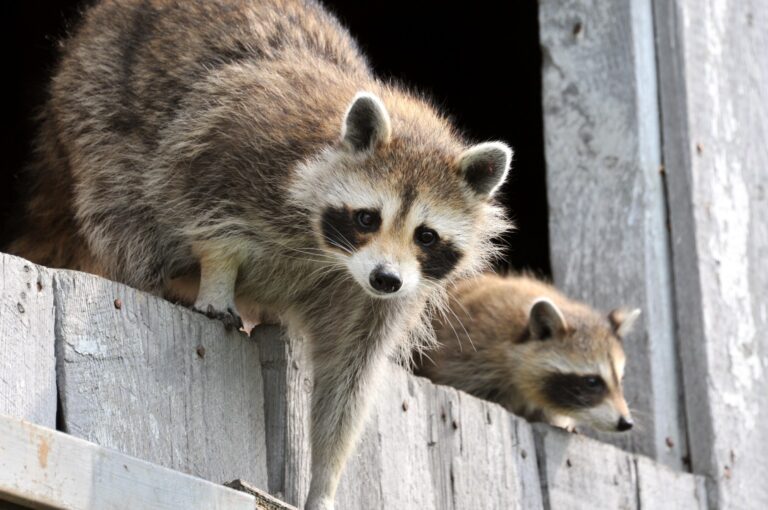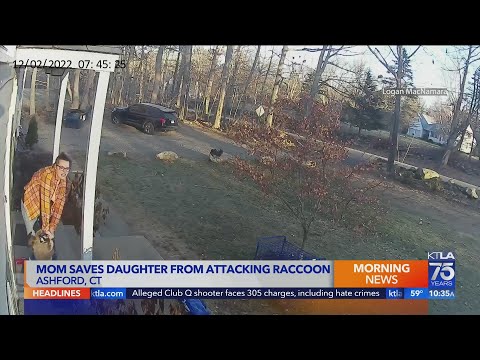There is hardly an animal out there that is more entertaining, and more charming, then the raccoon. Or rather, there are plenty charming as long as you aren’t the one enduring their attention!

Raccoons are notorious for breaking into garbage cans, outbuildings and sometimes even homes in their never-ending quest for food and nesting areas.
Amazingly intelligent, and capable of intricate and dexterous problem solving, raccoons can be one animal pest that is very difficult to control without resorting to lethal measures.
They can also get surprisingly big, and many of them are mean! This raises one obvious question: are raccoons dangerous to people?
Yes, raccoons are considered to be dangerous to people. A menace to our homes and animals alike, they can inflict a fairly significant bite and potentially carry the rabies virus.
They sure look cute and cuddly, and who can resist that black mask they have, but you’d be wise to leave raccoons well alone wherever you encounter them.
Even raccoons that hang out near cities and suburbs cannot be trusted and do behave unpredictably.
A good-natured handout might result in you getting a nasty bite with an accompanying infection. There is lots more to learn about raccoons, and particularly how they interact with people. I’ll tell you all about it down below.
Raccoons are mammals that are native to North America. They are known for their distinctive black masks around their eyes and bushy tails with black and white rings.
Raccoons are typically found in forested areas, but they’re also quite common in urban and suburban environments.
This is because human activity and habitation provides raccoons with easy sources of food rather than true habitat loss.
Speaking of food, raccoons are omnivorous, eating animal and plant matter alike. They will also readily eat human and pet food that is left out or found in garbage cans.
Raccoons are primarily active during the night and they are quite agile, able to climb trees and swim adeptly. This makes them a particular nuisance in the wee hours of the morning!
Raccoons are also famous, or rather infamous, for their intelligence and problem-solving abilities.
They’ve been known to use tools, such as rocks, to help them access food, and they can open complex locks and latches or negotiate obstacle courses to get at food or shelter.
It’s the quest for the latter than commonly sees raccoons invade homes and other structures, since they are looking for nesting sites.
Female raccoons typically give birth to litters of 2-5 cubs, and they are protective of their young.
It’s common to see family units or tight-knit bands of females living together, though most sexually natural males stay solo unless mating.
Because raccoons are so bold, invasive and adaptive, this regularly brings them in to close contact with people, sometimes with unfortunate results!
Generally no, though mother raccoons will ferociously try to protect her babies and nesting area.
This is one of the most common reasons raccoons wind up attacking people; humans try to displace or relocate the raccoons, and the captured critters go on the offensive!
Yes. Male raccoons, particularly those who are not sexually mature yet, sometimes form bands to hunt and forage together.
They can act aggressively toward each other in areas of competition such as food supply. Female raccoons with young will also be very aggressive toward any male since males often engage in infanticide.
Yes, but usually only when people are encroaching on their nest or young, when the raccoon is trapped, cornered or injured, or when raccoons have gotten so bold that they have lost their fear of people.
The latter is especially likely for raccoons that reside fulltime in a neighborhood or city.
Yes, there have been. Although rare, it is believed that a couple dozen people each year might be attacked by a raccoon and bitten, not including incidents associated with professional pest control or wildlife removal.
Most of these attacks are due to encroachment, although rabies is not out of the question.
Luckily, there has only been one known case where a person has died as a result of a raccoon attack, and that was due to rabies.
Three things, generally speaking:
- a person has cornered a raccoon or posed a physical threat to the raccoon or its young. In these cases, the animal will lash out in defense, and might fight ferociously rather than abandoning its kits.
- the animal is trapped or injured. Raccoons don’t know that people might just be trying to help, and will attack out of fear.
- the raccoon has lost its fear of humans for one reason or another. The most common reason is due to living around and among people in a built-up area, and especially due to people feeding them.
This is dangerous behavior as it can make a raccoon unafraid of humans faster, and more likely to act aggressively if confronted or denied food.
Another possible reason for a raccoon’s loss of fear is rabies. Raccoons can carry this disease, though not as often as popularly thought.
They also die quickly once they are contagious, so the rabies threat from raccoons is minimal. However, if you are ever bitten by any raccoon it’s important to seek medical assistance and get tested at once.
Not really. Raccoons are strong enough to climb and scurry around, and strong enough to deliver a pretty mean bite, but physically they are not threatening compared to a human.
Yes, and they will when called for! Biting is a raccoon’s only meaningful way of defending itself. They are actually very capable biters, with teeth adapted to crushing and tearing food.
And this means they can be dangerous when provoked or cornered, though overall they are much more of a nuisance animal than a true threat.
A raccoon attack consists of a charge or sometimes a mock charge followed by biting any part of their foe that is within reach.
Raccoons are pretty quick on the ground, so if you’re unable to move quickly (say, because you are under a deck) then the raccoon will be on you before you can escape. They will then bite repeatedly and sometimes claw the target…
As always, be especially vigilant when you must get close to a raccoon, and double your caution if one is acting erratically since it might have rabies!
The best defense is escape and evasion. If it’s possible, back away slowly, and avoid eye contact prior to the raccoon actually charging.
If impossible, protect yourself with whatever items you can put between you and the raccoon like a coat or a broomstick. Raccoons are not very big or strong, and easy to overpower with a sturdy shield or weapon.
In a worst-case scenario, you may need to stomp the raccoon to dispatch it. Don’t dry to grab it without sturdy gloves and gauntlets: they are wriggly, and have loose skin to help them avoid being snagged by predators, so the raccoon will be able to twist and go to work on your hands instead.
Do what you can to avoid being bitten, and get away when you can.
Yes, if they found a dead body, anyway. No raccoon would be so crazed or desperate as to attack a human as food. But they are scavengers, and they do eat meat, so a raccoon will likely take a bite from your body if you perish.
Yes, and quite a few! The most severe and notorious is rabies, and raccoons do carry this virus.
But raccoons can also spread other parasites and illnesses like salmonella, roundworm, leptospirosis, canine distemper, and more.
So it’s important to take care when dealing with a raccoon as even contact without bites or scratches can leave you open to infection.
 Like what you read?
Like what you read?
Then you’re gonna love my free PDF, 20 common survival items, 20 uncommon survival uses for each. That’s 400 total uses for these dirt-cheap little items!
Just enter your primary e-mail below to get your link:
We will not spam you.



 Watch this video on YouTube
Watch this video on YouTube